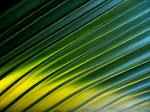
Arafat's trademark scarf is now military chic
Nina Lalli
Nina Lalli
NY Mirror:
Whatever your views of Yasser Arafat's complex political career, that man wore a scarf like no other. To attempt an exact reproduction of his distinctive folding and bunching (intended to mimic the shape of Palestine) would certainly be a loaded fashion statement, but as an accessory, the keffiyeh, a black-and-white or red-and-white checkered cotton scarf, is all the rage.
This observation is nothing new for Westerners: In the '80s, bohemian girls with dangly earrings and long, side-parted hair wore keffiyehs wrapped around their necks (rather than fixed on the head with a band called an agal), hanging in front—white fringe brushing shredded 501s. The scarves seemed to be for sale on almost every city street. These days, it takes a little more effort—a stroll down Brooklyn's Atlantic Avenue—to find them (about $5).
Many Americans strictly associate keffiyehs with the Palestinian movement and its late leader, but they are common to Arabs around the world. With the Middle East consistently the focus of world news, the scarves have also caught the eye of the fashion world. A few years ago, they became extremely popular among Tokyo teenagers, who buy them from army-surplus vendors. They often pair the scarves with camouflage, treating them much in the way American rappers and yuppies alike wear army t-shirts and other military gear. In recent months, New Yorkers have also revisited the keffiyeh. Our spies are suddenly spotting it right and left (no, it's not quite on the scale of ponchos, but it's out there), on hip youngsters at parties, art openings, and at clubs.
Most non-Arab New Yorkers wear them in one of three ways. Pro-Palestinian activists usually drape them loosely over their shoulders, as was recently seen at anti-war protests. World-music types bunch them to make a regular, long scarf, as girls did in the '80s. And the hippest kids fold the square in half to make a triangle and gather it around the neck, center point-down over their chests. This is similar to the way U.S. and British troops wear the scarves in Iraq and Afghanistan—to protect the face in sandstorms. (In that context, the keffiyeh is called a shemagh.) It may be no different in spirit from wearing camouflage, but it's certainly more likely to raise eyebrows.
This observation is nothing new for Westerners: In the '80s, bohemian girls with dangly earrings and long, side-parted hair wore keffiyehs wrapped around their necks (rather than fixed on the head with a band called an agal), hanging in front—white fringe brushing shredded 501s. The scarves seemed to be for sale on almost every city street. These days, it takes a little more effort—a stroll down Brooklyn's Atlantic Avenue—to find them (about $5).
Many Americans strictly associate keffiyehs with the Palestinian movement and its late leader, but they are common to Arabs around the world. With the Middle East consistently the focus of world news, the scarves have also caught the eye of the fashion world. A few years ago, they became extremely popular among Tokyo teenagers, who buy them from army-surplus vendors. They often pair the scarves with camouflage, treating them much in the way American rappers and yuppies alike wear army t-shirts and other military gear. In recent months, New Yorkers have also revisited the keffiyeh. Our spies are suddenly spotting it right and left (no, it's not quite on the scale of ponchos, but it's out there), on hip youngsters at parties, art openings, and at clubs.
Most non-Arab New Yorkers wear them in one of three ways. Pro-Palestinian activists usually drape them loosely over their shoulders, as was recently seen at anti-war protests. World-music types bunch them to make a regular, long scarf, as girls did in the '80s. And the hippest kids fold the square in half to make a triangle and gather it around the neck, center point-down over their chests. This is similar to the way U.S. and British troops wear the scarves in Iraq and Afghanistan—to protect the face in sandstorms. (In that context, the keffiyeh is called a shemagh.) It may be no different in spirit from wearing camouflage, but it's certainly more likely to raise eyebrows.


No comments:
Post a Comment